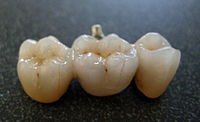
Photo from wikipedia
Background: Progressive attachment loss around the teeth because of periodontal disease can result in increased tooth mobility. This adversely affects patient's comfort, function, and esthetics. Periodontal splinting helps in accomplishing… Click to show full abstract
Background: Progressive attachment loss around the teeth because of periodontal disease can result in increased tooth mobility. This adversely affects patient's comfort, function, and esthetics. Periodontal splinting helps in accomplishing stability by redistributing the functional and parafunctional forces. There are various materials that have been used for periodontal splinting. Fiber-reinforced composite, composite resin, and metal-reinforced composite are often used as splinting materials for periodontally compromised teeth. In our study, a comparison was done among these materials for their ability to distribute the stresses at different bone levels in mobile lower incisors splinted together with canines. Materials and Methods: Five patients of age group 25–50 years with Grade 2 and 3 mobile incisors having 40% or more bone loss and firm canines with optimal bone support were selected. From the computed tomography scan of each patient, three models were developed demonstrating splinting of mandibular incisors and canines with metal-reinforced composite, fiber-reinforced composite, and composite resin. So in total, 15 models were developed and each one of them was subjected to vertical and transverse loads of 150 N. Pattern of stress distribution was observed in these models using three-dimensional finite element analysis. Results: After splinting, the stress on the canine increased when bone levels around incisors decreased while stress on incisors reduced. Conclusion: Tested splinting materials were successful in stress distribution, and metal-reinforced composite was found to be better than the other splinting materials.
Journal Title: Indian Journal of Dental Research
Year Published: 2019
Link to full text (if available)
Share on Social Media: Sign Up to like & get
recommendations!